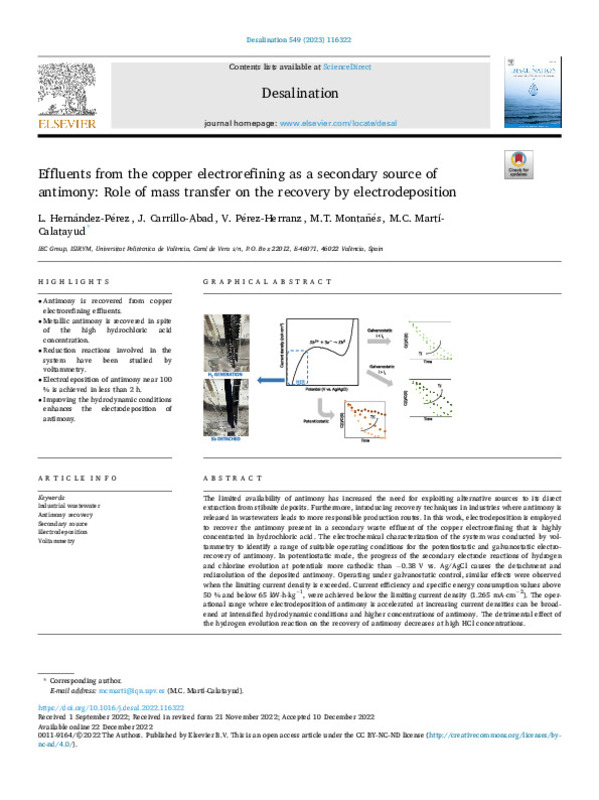JavaScript is disabled for your browser. Some features of this site may not work without it.
Buscar en RiuNet
Listar
Mi cuenta
Estadísticas
Ayuda RiuNet
Admin. UPV
Effluents from the copper electrorefining as a secondary source of antimony: Role of mass transfer on the recovery by electrodeposition
Mostrar el registro sencillo del ítem
Ficheros en el ítem
| dc.contributor.author | Hernández-Pérez, Lorena
|
es_ES |
| dc.contributor.author | Carrillo-Abad, Jordi
|
es_ES |
| dc.contributor.author | Pérez-Herranz, Valentín
|
es_ES |
| dc.contributor.author | Montañés, Maria-Teresa
|
es_ES |
| dc.contributor.author | Martí Calatayud, Manuel César
|
es_ES |
| dc.date.accessioned | 2024-04-11T09:56:50Z | |
| dc.date.available | 2024-04-11T09:56:50Z | |
| dc.date.issued | 2023-03-01 | es_ES |
| dc.identifier.issn | 0011-9164 | es_ES |
| dc.identifier.uri | http://hdl.handle.net/10251/203362 | |
| dc.description.abstract | [EN] The limited availability of antimony has increased the need for exploiting alternative sources to its direct extraction from stibnite deposits. Furthermore, introducing recovery techniques in industries where antimony is released in wastewaters leads to more responsible production routes. In this work, electrodeposition is employed to recover the antimony present in a secondary waste effluent of the copper electrorefining that is highly concentrated in hydrochloric acid. The electrochemical characterization of the system was conducted by voltammetry to identify a range of suitable operating conditions for the potentiostatic and galvanostatic electro-recovery of antimony. In potentiostatic mode, the progress of the secondary electrode reactions of hydrogen and chlorine evolution at potentials more cathodic than ¿0.38 V vs. Ag/AgCl causes the detachment and redissolution of the deposited antimony. Operating under galvanostatic control, similar effects were observed when the limiting current density is exceeded. Current efficiency and specific energy consumption values above 50 % and below 65 kW·h·kg¿1, were achieved below the limiting current density (1.265 mA·cm¿2). The operational range where electrodeposition of antimony is accelerated at increasing current densities can be broadened at intensified hydrodynamic conditions and higher concentrations of antimony. The detrimental effect of the hydrogen evolution reaction on the recovery of antimony decreases at high HCl concentrations. | es_ES |
| dc.description.sponsorship | The authors thank the financial support from the Agencia Estatal de Investigacion (AEI/10.13039/501100011033) (Spain) under the project PCI2019-103535 and by FEDER A way of making Europe. Funding for open access charge: CRUE-Universitat Politecnica de Valencia. | es_ES |
| dc.language | Inglés | es_ES |
| dc.publisher | Elsevier | es_ES |
| dc.relation.ispartof | Desalination | es_ES |
| dc.rights | Reconocimiento - No comercial - Sin obra derivada (by-nc-nd) | es_ES |
| dc.subject | Industrial wastewater | es_ES |
| dc.subject | Antimony recovery | es_ES |
| dc.subject | Secondary source | es_ES |
| dc.subject | Electrodeposition | es_ES |
| dc.subject | Voltammetry | es_ES |
| dc.subject.classification | INGENIERIA QUIMICA | es_ES |
| dc.title | Effluents from the copper electrorefining as a secondary source of antimony: Role of mass transfer on the recovery by electrodeposition | es_ES |
| dc.type | Artículo | es_ES |
| dc.identifier.doi | 10.1016/j.desal.2022.116322 | es_ES |
| dc.relation.projectID | info:eu-repo/grantAgreement/AEI/Plan Estatal de Investigación Científica y Técnica y de Innovación 2017-2020/PCI2019-103535/ES/ELECTRO-ELECTRODIALISIS APLICADA A LA INDUSTRIA DE PROCESAMIENTO DE MINERALES DE COBRE PARA LA RECUPERACION DE ANTIMONIO DE LAVADOS DE MINAS Y RECICLAJE DE LA DISOLUCION/ | es_ES |
| dc.rights.accessRights | Abierto | es_ES |
| dc.contributor.affiliation | Universitat Politècnica de València. Escuela Técnica Superior de Ingenieros Industriales - Escola Tècnica Superior d'Enginyers Industrials | es_ES |
| dc.description.bibliographicCitation | Hernández-Pérez, L.; Carrillo-Abad, J.; Pérez-Herranz, V.; Montañés, M.; Martí Calatayud, MC. (2023). Effluents from the copper electrorefining as a secondary source of antimony: Role of mass transfer on the recovery by electrodeposition. Desalination. 549. https://doi.org/10.1016/j.desal.2022.116322 | es_ES |
| dc.description.accrualMethod | S | es_ES |
| dc.relation.publisherversion | https://doi.org/10.1016/j.desal.2022.116322 | es_ES |
| dc.type.version | info:eu-repo/semantics/publishedVersion | es_ES |
| dc.description.volume | 549 | es_ES |
| dc.relation.pasarela | S\479662 | es_ES |
| dc.contributor.funder | AGENCIA ESTATAL DE INVESTIGACION | es_ES |
| dc.contributor.funder | European Regional Development Fund | es_ES |
| dc.contributor.funder | Universitat Politècnica de València | es_ES |
| dc.subject.ods | 06.- Garantizar la disponibilidad y la gestión sostenible del agua y el saneamiento para todos | es_ES |
| dc.subject.ods | 09.- Desarrollar infraestructuras resilientes, promover la industrialización inclusiva y sostenible, y fomentar la innovación | es_ES |
| dc.subject.ods | 12.- Garantizar las pautas de consumo y de producción sostenibles | es_ES |








